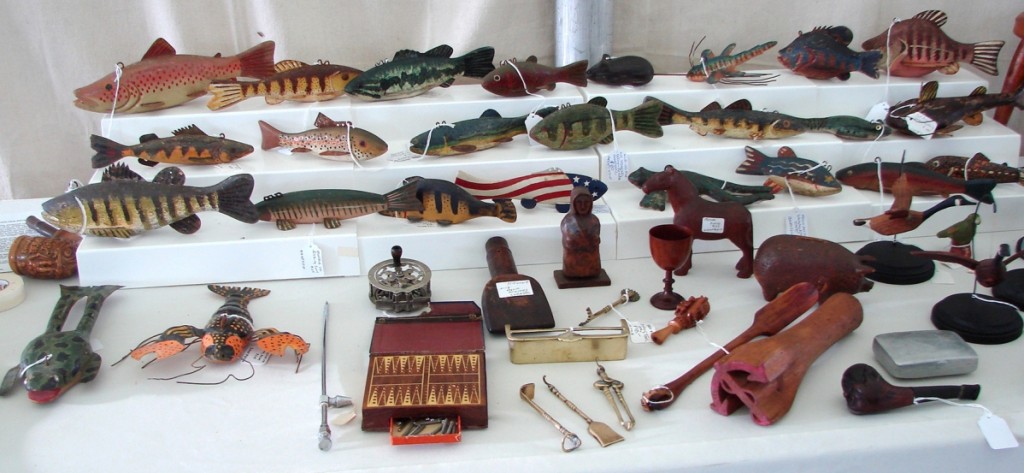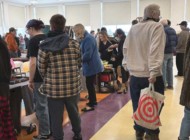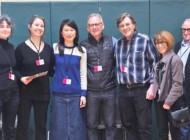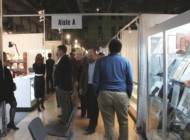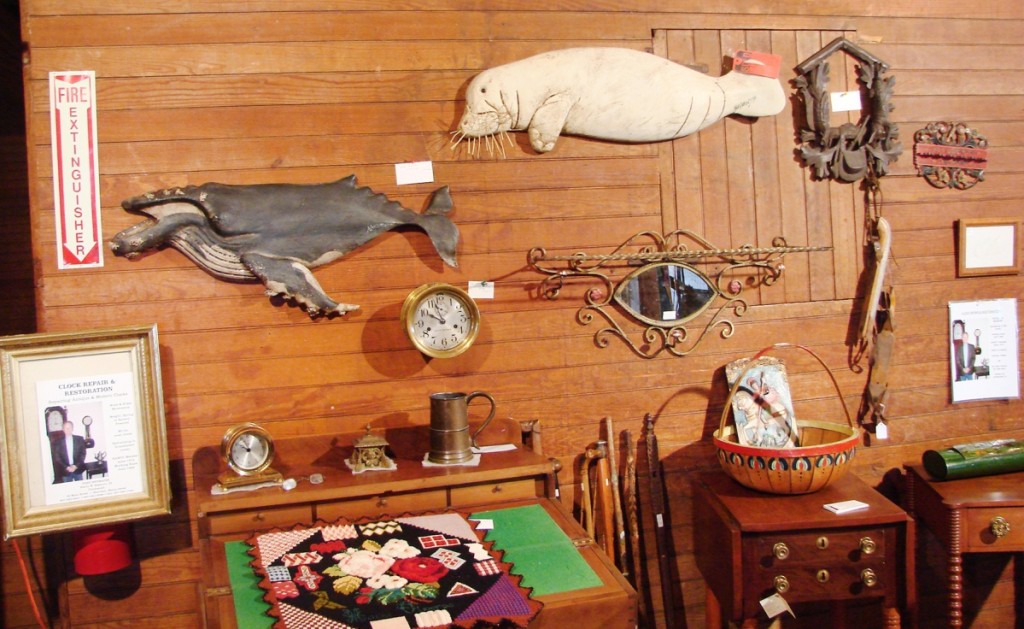
Harry Hepburn, Harrison, Maine, showcased two wonderful carvings by Wick Ahrens (1944–2016). The walrus, painted white, had a sold tag on it, and the other was of a whale, priced at $1,950.
Review and Photos by Rick Russack
WELLS, MAINE – Luck was on the side of Liz and John DeSimone for their June 30 show on the grounds of the historic Laudholm Farm. Weather forecasts had been borderline between sun and heavy rain, but the morning of the show was both sunny and comfortable. The parking lot was full and the line was long. Usually, the show has several dealers set up outside, as well as in the barn and in large tents. To be on the safe side, a few days before the show, the DeSimones decided to add another large tent so that, in case of rain, most of the 75 or so dealers would be under cover.
Laudholm Farm traces its history back to 1642. In 1881, the property was purchased by George C. Lord, president of the Boston and Maine Railroad, who, of course, built his own personal railroad station on the property. Succeeding generations of the Lord family developed the property into a large, modern dairy farm, renamed Laudholm Farms, with a large herd of Guernsey cows until the herd was sold in 1952. Laudholm Farms dairy and poultry products were sold locally and shipped to Boston. After the death of another George Lord in 1977, local residents, concerned about the future of the property, set up a trust in 1982 to preserve the farm.
The show certainly had a country flavor, but there was a wide variety of offerings. Folk art, early furniture, trade signs, hooked rugs, paintings and books were displayed along with jewelry, some Twentieth Century material, Chinese export porcelains, early glass and much more.
For years, Connecticut dealers Paul and Karen Wendhiser have primarily dealt in early, country material. At this show, half of their booth displayed mid-Twentieth Century items. When asked about the shift, Paul said, “You have to change with the times – or else.” One of their interesting pieces was an example of kinechromatic art, a type of art in which the image, especially in respect to the colors the viewer sees, will change as the object is moved. The piece they had was a lucite figure of an owl, 6½ inches tall, and as the piece was turned in different directions, its appearance changed. It was signed by Abraham Palatnik, a Brazilian artist born in 1928 and was stamped Brazil on the base. Palatnik is considered an originator of this type of art and examples of his work are in the collection of the Museum of Modern Art. He was also included in a group show at the Met Breuer. The Wendhisers priced the owl at $160. Other midcentury offerings included an offset lithographed poster by Andy Warhol of Goethe. It was priced at $1,100 by John Bourne, Pittsford, Vt., and was part of a series of four that Warhol did of Johann Wolfgang von Goethe (1749-1832) in the 1980s.
As one might expect, there was plenty of folk art at the show. Steve Corrigan and Doug Jackman, owners of Stephen-Douglas Antiques, Rockingham, Vt., had a showstopper trade sign priced $3,950. Probably safe to call unique, the sign was a large tin cornucopia, about 5 feet long, spilling out painted tin fruits and vegetables. For years, it had hung at Abenaki Springs Farms in Walpole, N.H., and was recently “deaccessioned.” The dealers’ booth at this show is a whole room in the barn and it was filled with folk art, woodenware, stoneware, early ceramics, painted furniture and more.
Just next door to their booth, was the display of Jim and Nancy Glazer, Bailey Island, Maine. They had an interesting folk art carved and painted sign from a church in Boothbay Harbor depicting the church as well as the steamer Nahanda. The Glazers had collected some real photo postcards showing the steamer at Hell Gate, a notoriously difficult point on the Kennebec River. The Glazers also had a collection of Victorian era pen-wipes, most in the form of animals.
John Bourne had a folk art “weathervane,” although it did not have directionals. What it did have was a well-carved wooden horse with good patina and six colorful wooden “lollipops.” As the lollipops turned, so did the horse, and its head went up and down. Harry Hepburn, Harrison, Maine, had two carvings by Wick Ahrens (1944-2016). One, a walrus, painted white, had a sold tag on it, and the other was of a whale.
Bob Markowitz, Groveland, Mass., had a piece of Judaic folk art – a colorful Twentieth Century needlework on pierced cardboard mizrah, depicting a seven-light candleholder and pilasters from the Temple of Solomon. Mizrah is the Hebrew word for “east” and is the direction that Jews outside of Israel face when praying. Markowitz priced the unusual item at $350.
A good assortment of formal furniture was on the field. Heller-Washam, Portland, Maine, brought several pieces, including a Queen Anne drop leaf table, circa 1750, and two Federal card tables. One, a demilune form, was priced at $985, and the other, which Kim Washam thought was probably from Salem, Mass., circa 1790-1810, was priced at $1,250. She said certain construction details made her think it may have been a Seymour piece. They priced a circa 1840-50 painted Empire secretary at a reasonable $750.
Martin Ferrick, from Lincolnville, Maine, had, as he always does, several pieces, including an attractive flame birch, four-drawer chest with original brass, circa 1810, and he also had a birch slant-front desk. Greg Hamilton had a Pennsylvania nine-drawer walnut tall chest, dating to 1780-1810, for which he was asking $5,200.
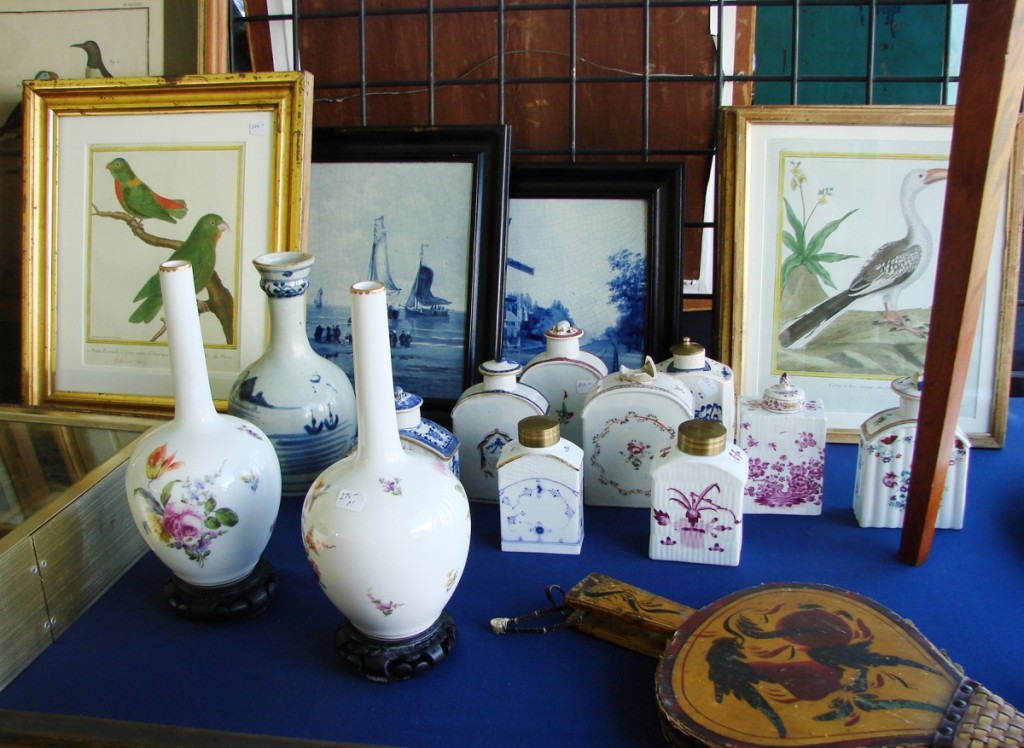
Greg Hamilton, Stone Block Antiques, Vergennes, Vt., offered a selection of Chinese export porcelain tea caddies in the $200 price range. The pair of vases was priced at $275.
Offering early American glass, Brian Cullity, Sagamore, Mass., had a selection of aqua flasks priced between $100 and $250, along with other early glass. He also had a small collection of pre-Columbian items, including a carved stone ear of maize, which he dated between 1000 and 1400 CE. He commented that pre-Columbian items are quite reasonably priced in today’s market.
If you were looking for early ceramics, there was plenty from which to choose – including an Eighteenth Century French faience vase dated 1721 in the booth of John Prunier, Warren, Mass. He was asking $1,100.
Justin Cobb, Captain’s Quarters Antiques, Amherst, Mass., had been a fixture at this show for several years. Justin died in April at the age of 92, but his son Jeff is carrying on the business, and was in his father’s regular space. “My brothers and I plan to continue the business,” he said. “We all grew up with the stuff, and there’s plenty of it. So the business will continue.”
The DeSimones, with an eye on an ominous, approaching cloud, ended the show early, telling dealers they could leave around 2 pm. A storm at this show a couple of years ago, with strong winds and heavy rains, knocked over tents and drenched everyone and everything. It has entered the folklore of New England dealers, and John and Liz did not want a repeat.
Show advertising succeeded in bringing numerous younger families with small children, a demographic not seen often enough at shows. A couple of days after the show, John DeSimone credited that to their internet advertising. “We were pleasantly surprised with the number of younger families. It was a good day, in spite of the weather forecasts, and our attendance was pretty much the same as last year. We were satisfied, and several dealers told us that they had had a good show. That’s what it’s all about.”
For information, 800-641-6908 or goosefare@gwi.net.

